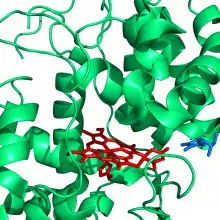Ascorbate peroxidase
Ascorbate peroxidase (or APX) is a member of the family of heme-containing peroxidases. Heme peroxidases catalyse the H2O2-dependent oxidation of a wide range of different, usually organic, substrates in biology.

Overview
Ascorbate-dependent peroxidase activity was first reported in 1979,[1],[2] more than 150 years after the first observation of peroxidase activity in horseradish plants[3] and almost 40 years after the discovery of the closely related cytochrome c peroxidase enzyme.[4]
Peroxidases have been classified into three types (class I, class II and class III): ascorbate peroxidases is a class I peroxidase enzyme.[5] APXs catalyse the H2O2-dependent oxidation of ascorbate in plants, algae and certain cyanobacteria.[6] APX has high sequence identity to cytochrome c peroxidase, which is also a class I peroxidase enzyme. Under physiological conditions, the immediate product of the reaction, the monodehydroascorbate radical, is reduced back to ascorbate by a monodehydroascorbate reductase (monodehydroascorbate reductase (NADH)) enzyme. In the absence of a reductase, two monodehydroascorbate radicals disproportionate rapidly to dehydroascorbic acid and ascorbate. APX is an integral component of the glutathione-ascorbate cycle.[7]
Substrate specificity
APX enzymes show high specificity for ascorbate as an electron donor, but most APXs will also oxidise other organic substrates that are more characteristic of the class III peroxidases (such as horseradish peroxidase), in some cases at rates comparable to that of ascorbate itself. This means that defining an enzyme as an APX is not straightforward, but is usually applied when the specific activity for ascorbate is higher than that for other substrates.
Mechanism
Most of the information on mechanism comes from work on the pea cytosolic and soybean cytosolic enzymes. The mechanism of oxidation of ascorbate is achieved by means of an oxidized Compound I intermediate, which is subsequently reduced by substrate in two, sequential single electron transfer steps (equations [1]–[3], where HS = substrate and S• = one electron oxidised form of substrate).
- APX + H2O2 → Compound I + H2O [1]
- Compound I + HS → Compound II + S• [2]
- Compound II + HS → APX + S• + H2O [3]
In ascorbate peroxidase, Compound I is a transient (green) species and contains a high-valent iron species (known as ferryl heme, FeIV) and a porphyrin pi-cation radical,[8],[9] as found in horseradish peroxidase. Compound II contains only the ferryl heme.
Structural information
The structure of pea cytosolic APX was reported in 1995.[10] The binding interaction of soybean cytosolic APX with its physiological substrate, ascorbate[11],[12] and with a number of other substrates[13] are also known.
Applications in cellular imaging
Both pea APX[14] and soybean APX[15] have been used in electron microscopy studies for cellular imaging.
References
- Kelly GJ, Latzko E (1979). "Soluble ascorbate peroxidase: detection in plants and use in vitamim C estimation". Naturwissenschaften. 66 (12): 617–619. doi:10.1007/bf00405128. PMID 537642.
- Groden D, Beck E (1979). "H2O2 destruction by ascorbate-dependent systems from chloroplasts". Biochim. Biophys. Acta. 546 (3): 426–435. doi:10.1016/0005-2728(79)90078-1. PMID 454577.
- Planche, LA. (1810) Bull. Pharm., 2, 578
- Altschul AM, Abrams R, Hogness TR (1940). "Cytochrome c Peroxidase" (PDF). J. Biol. Chem. 136: 777–794.
- Welinder KG (1992). "Superfamily of plant, fungal and bacterial peroxidases". Curr. Opin. Chem. Biol. 2 (3): 388–393. doi:10.1016/0959-440x(92)90230-5.
- Raven EL (2003). "Understanding functional diversity and substrate specificity in haem peroxidases: what can we learn from ascorbate peroxidase?". Nat. Prod. Rep. 20 (4): 367–381. doi:10.1039/B210426C. PMID 12964833.
- Noctor G, Foyer CH (Jun 1998). "Ascorbate and Glutathione: Keeping Active Oxygen Under Control". Annu Rev Plant Physiol Plant Mol Biol. 49: 249–279. doi:10.1146/annurev.arplant.49.1.249. PMID 15012235.
- Patterson WR; Poulos TL; Goodin, DB (1995). "Identification of a porphyrin pi cation radical in ascorbate peroxidase compound I.". Biochemistry. 34 (13): 4342–4345. doi:10.1021/bi00013a024. PMID 7703248.
- Jones, DK; Dalton DA; Rosell FI; Raven, E (1998). "Class I heme peroxidases: characterization of soybean ascorbate peroxidase". Arch. Biochem. Biophys. 360 (2): 173–178. doi:10.1006/abbi.1998.0941. PMID 9851828.
- Patterson, WR; Poulos, TL (1995). "Crystal structure of recombinant pea cytosolic ascorbate peroxidase". Biochemistry. 34 (13): 4331–4341. doi:10.1021/bi00013a023. PMID 7703247.
- Sharp, KH; Mewies, M; Moody, PCE; Raven, EL (2003). "Crystal structure of the ascorbate peroxidase-ascorbate complex". Nat. Struct. Biol. 10 (4): 303–307. doi:10.1038/nsb913. PMID 12640445.
- Macdonald IK; Badyal SK; Ghamsari L, Moody; PC, Raven EL (2006). "Interaction of ascorbate peroxidase with substrates: a mechanistic and structural analysis". Biochemistry. 45 (25): 7808–7817. doi:10.1021/bi0606849. PMID 16784232.
- Gumiero, AG; Murphy, EJ; Metcalfe, CL; Moody, PCE; Raven, EL (2010). "An analysis of substrate binding interactions in the heme peroxidase enzymes: a structural perspective". Arch. Biochem. Biophys. 500 (1): 13–20. doi:10.1016/j.abb.2010.02.015. PMID 20206594.
- Martell JD, Deerinck TJ, Sancak Y, Poulos TL, Mootha VK, Sosinsky GE, Ellisman MH, Ting AY (2012). "Engineered ascorbate peroxidase as a genetically encoded reporter for electron microscopy". Nature Biotechnology. 30 (11): 1143–1148. doi:10.1038/nbt.2375. PMC 3699407. PMID 23086203.
- Lam SS, Martell JD, Kamer KJ, Deerinck TJ, Ellisman MH, Mootha VK, Ting AY (2015). "Directed evolution of APEX2 for electron microscopy and proximity labeling". Nature Methods. 12 (1): 51–54. doi:10.1038/nmeth.3179. PMC 4296904. PMID 25419960.